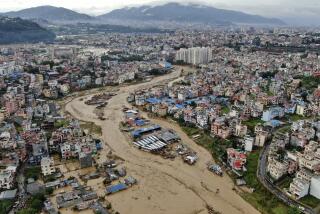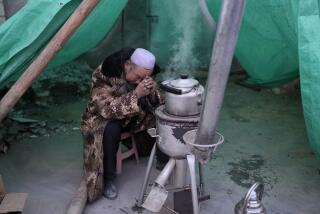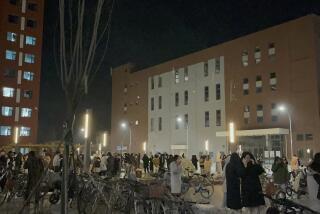Quake kills at least 40, injures hundreds in India, Nepal and Tibet
Reporting from Imphal, India — Rain, landslides and severed communications hampered rescue efforts Monday hours after a magnitude 6.8 earthquake hit northeastern India, Nepal and Tibet, killing at least 40 people and injuring hundreds.
With many roads to the epicenter area in India’s northeastern Sikkim state cut off, experts said they expected the death toll to rise once emergency workers reach isolated communities in coming hours and days. Working in the Himalayan state’s favor is its relatively few residents, about 500,000, making it India’s least populated.
Photos: Earthquake hits India, Nepal and Tibet
Television footage of the worst-hit area near Mangan, a Sikkim community approximately 30 miles from the Nepal border, showed widespread destruction, including massive road buckling, destroyed buildings, landslide-blocked mountain highways that forced hundreds of people to walk to rescue centers.
India’s Home Ministry reported 16 landslides in a single six-mile stretch of road in Sikkim, with several major thoroughfares washed away.
Helicopters and about 4,000 army troops called into help after the Sunday earthquake, which struck shortly after 6 p.m., were unable to reach the affected area well into Monday afternoon because of storms and heavy cloud cover. About 22 tourists were reportedly rescued by border police.
P.M. Rai, a lawmaker from Sikkim, said early tallies suggested at least 150 people were in area hospitals with a host of injuries, including a significant number suffering from trauma.
Authorities said this was the fourth earthquake to hit India in recent months and the worst to hit Sikkim in six decades. There were no immediate reports of damage to dams in the mountainous state.
Preliminary reports suggested at least 28 were killed in India, seven in Nepal and, according to China’s state-run Xinhua news service, seven in Tibet.
Although power was restored Monday morning to Gangtok, Sikkim’s state capital, it remained off in smaller communities. Many residents were reportedly traumatized by about 20 aftershocks overnight.
Photos: Earthquake hits India, Nepal and Tibet
Angeli Qwantra, a disaster-management expert, told local network CNN/IBN that the aftermath underscored how unprepared Sikkim and the entire nation were in a country that is prone to earthquakes. The amount of building damage also suggested building codes were not enforced, she said, adding that Indian authorities should have done a much better job reaching the affected area hours earlier.
“The first hour is the golden hour to save lives,” she said. “Those under debris are not being rescued. This means there will be more infection, amputation of limbs, kidney failure. The death toll will rise.”
More to Read
Sign up for Essential California
The most important California stories and recommendations in your inbox every morning.
You may occasionally receive promotional content from the Los Angeles Times.










